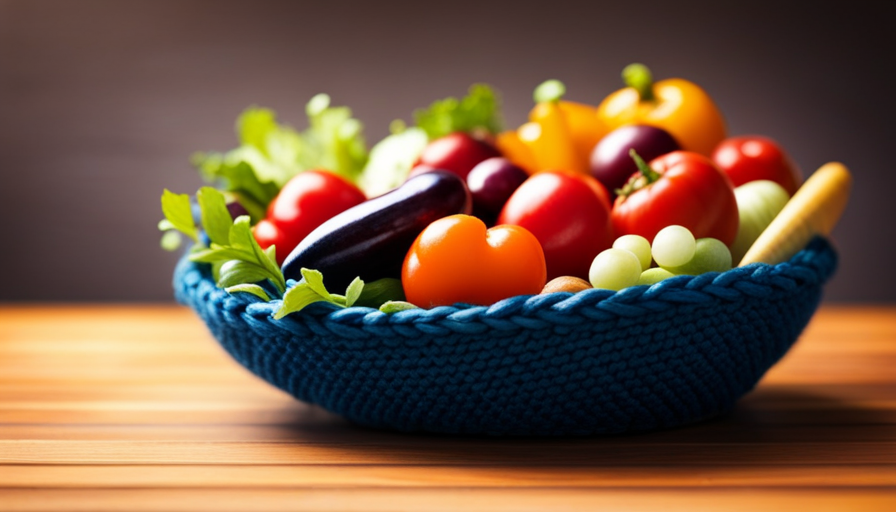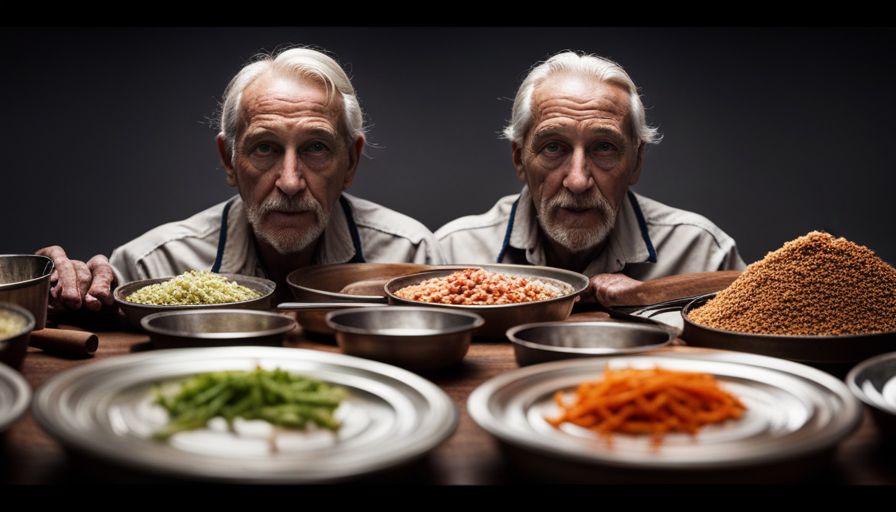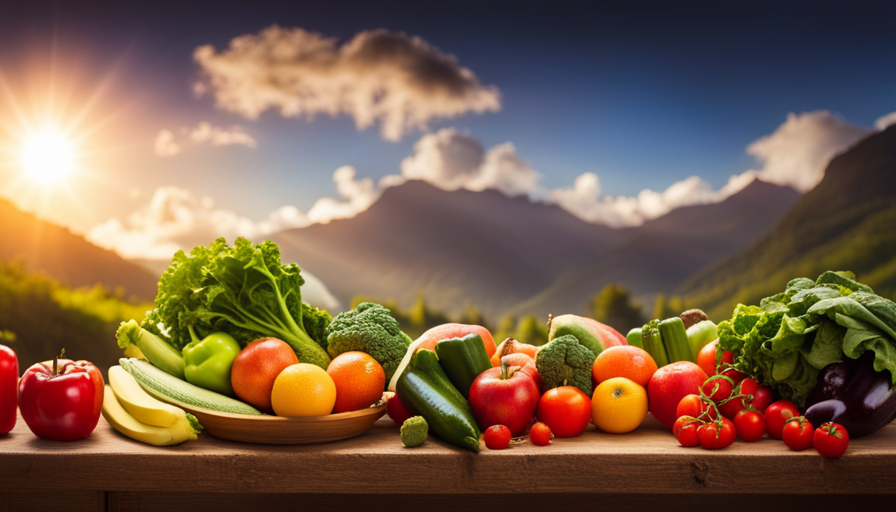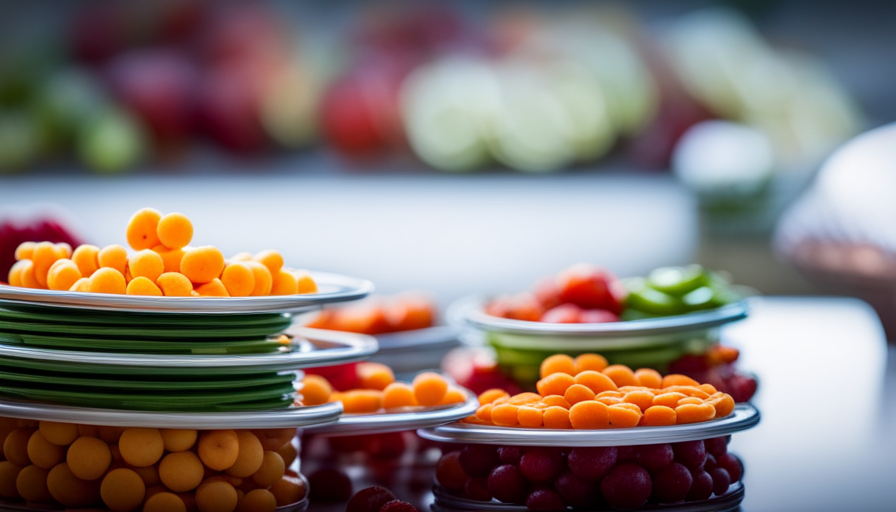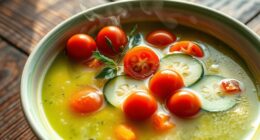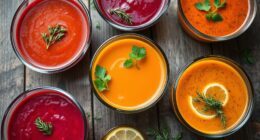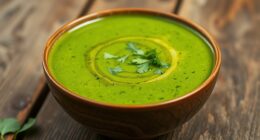Ever thought about ways to elevate your raw food experience beyond just the dishes you make? The raw food movement goes beyond food, focusing on adopting a holistic lifestyle that encourages well-being and eco-friendliness.
One way to immerse yourself in this lifestyle is through various crafts that complement the raw food movement. From homemade kitchen tools to natural skincare products, there are endless creative opportunities to explore.
In this article, I will introduce you to a range of crafts that align with the raw food philosophy. Whether you are a seasoned raw foodist or simply curious about incorporating more raw foods into your diet, these crafts will add depth and creativity to your journey.
Get ready to discover the exciting world of DIY food preservation techniques, natural dyeing with food, and much more. Let’s dive in and explore the wonderful world of crafts that go hand in hand with the raw food movement.
Key Takeaways
- Crafts such as homemade kitchen tools and handmade recipe books align with the principles of the raw food movement and add depth to the journey.
- DIY food preservation techniques like dehydrating, fermenting, canning, and pickling complement the raw food movement and promote food preservation.
- Natural dyeing with food, tie-dye and Shibori techniques, and eco-printing with plant materials are crafts that can enhance handmade creations and add natural beauty to raw food-related projects.
- Artwork inspired by raw food can capture the freshness and vitality of raw food ingredients and can be created through various art techniques such as painting, drawing, or mixed media collages.
Homemade Kitchen Tools
You can’t resist the satisfaction and empowerment you feel when using your own homemade kitchen tools in the raw food movement. Not only do homemade kitchen tools add a personal touch to your food preparation, but they also align perfectly with the principles of the raw food movement.
By creating your own tools, you have complete control over their materials and design, ensuring they’re free from harmful chemicals and toxins.
One popular homemade kitchen tool in the raw food movement is a dehydrator. With this simple device, you can preserve the natural goodness of fruits, vegetables, and herbs while retaining their nutritional value. Additionally, making your own dehydrator allows you to customize its features, such as temperature control and size, to suit your specific needs.
Another homemade kitchen tool that complements the raw food movement is a nut milk bag. This versatile tool is used to strain homemade nut milk, yogurt, and even natural skincare products. By using a nut milk bag, you can eliminate the need for store-bought, processed alternatives, ensuring that your food and skincare products are free from additives and preservatives.
Incorporating homemade kitchen tools into the raw food movement not only enhances your culinary experience but also promotes a healthier and more sustainable lifestyle.
Now, let’s explore some DIY food preservation techniques that further support the raw food movement.
DIY Food Preservation Techniques
I love finding ways to preserve my own food at home. One technique I enjoy is dehydrating fruits and vegetables. It’s a simple process that allows me to enjoy the flavors of summer all year round.
Another method I’ve learned is fermenting foods, which not only adds a unique tangy taste but also provides added health benefits through probiotics.
Lastly, I’ve also dabbled in the art of canning and pickling. It’s a great way to preserve the harvest and experiment with different flavors.
Make your own dehydrated fruits and vegetables
To make your own dehydrated fruits and vegetables, all you need is a dehydrator, which can retain up to 90% of the nutrients compared to traditional cooking methods. Using a dehydrator is a simple and effective way to preserve fruits and vegetables, allowing you to enjoy them year-round. You can create homemade fruit leather by pureeing fruits and spreading the mixture onto the dehydrator trays. This tasty snack is a great alternative to store-bought fruit roll-ups, as it contains no added sugars or preservatives. Another popular option is DIY vegetable chips, which are made by thinly slicing vegetables and dehydrating them until crispy. This healthy alternative to potato chips is packed with nutrients and can be flavored with various spices for added taste. With a dehydrator, the possibilities are endless for creating nutritious and delicious snacks. Transitioning into the subsequent section, learning how to ferment foods for added health benefits is another craft that pairs well with the raw food movement.
Learn how to ferment foods for added health benefits
Discover the art of fermenting foods to unlock their hidden health benefits and create a vibrant array of flavors and textures. Fermented foods have been consumed for centuries and are known for their numerous health benefits. Here are four reasons why you should incorporate fermented foods into your diet:
-
Gut Health: Fermented foods are rich in probiotics, which promote a healthy gut microbiome and aid in digestion.
-
Improved Nutrient Absorption: The fermentation process enhances the bioavailability of nutrients in foods, making them easier for the body to absorb.
-
Boosted Immune System: Probiotics found in fermented foods can strengthen the immune system, leading to better overall health.
-
Increased Food Preservation: Fermenting foods not only extends their shelf life but also adds unique flavors and textures.
As you explore the art of fermenting, you’ll quickly realize the incredible health benefits and culinary possibilities. Now, let’s transition into the subsequent section where we’ll delve into the fascinating world of canning and pickling.
Explore the art of canning and pickling
Delve into the fascinating world of canning and pickling, where the art of preserving food is like a symphony of flavors, creating a harmonious blend that dances on your taste buds. Canning techniques have been utilized for centuries to extend the shelf life of fruits, vegetables, and even meats. By sealing food in airtight containers, you can enjoy the taste of summer’s bounty all year round. Pickling takes it a step further, infusing ingredients with tangy and savory flavors that elevate any dish. From classic dill pickles to creative recipes like pickled watermelon rinds or spicy pickled carrots, there are endless possibilities to explore. To inspire your culinary adventures, here is a table showcasing some popular canning techniques and creative pickle recipes:
| Canning Techniques | Creative Pickle Recipes |
|---|---|
| Water bath canning | Classic dill pickles |
| Pressure canning | Spicy pickled carrots |
| Fermentation | Pickled watermelon rinds |
Now that you’ve mastered the art of canning and pickling, let’s dive into the world of handmade recipe books.
Handmade Recipe Books
Handmade recipe books are a must-have for anyone looking to explore the delicious world of raw food. These books aren’t just practical but also serve as a personal reflection of one’s culinary journey.
One way to create a personalized recipe journal is by making handmade recipe cards. These cards can be beautifully designed and customized with unique artwork or photographs, making them a joy to use and share with others. Additionally, handmade recipe books allow for the inclusion of personal notes, tips, and modifications to recipes, making them a valuable resource for future reference.
When creating a handmade recipe book, it’s important to choose high-quality materials that’ll withstand the test of time. Opt for acid-free paper and durable binding methods to ensure longevity. Additionally, consider organizing the book by categories such as appetizers, main dishes, desserts, and beverages to make it easier to navigate.
As we delve into the topic of natural dyeing with food, it’s important to note that this craft can be a wonderful complement to the raw food movement. By using ingredients like fruits, vegetables, and spices, one can create vibrant and unique dyes for fabrics and yarns.
Let’s explore the art of natural dyeing and discover how it can enhance our appreciation for both food and crafts.
Natural Dyeing with Food
I love exploring natural dyeing techniques using fruits and vegetables to create vibrant fabric dyes. It’s amazing how you can transform ordinary produce into beautiful, eco-friendly colors for your fabrics.
I’ve been experimenting with different techniques like tie-dye and Shibori, and it’s been so much fun seeing the unique patterns and designs that can be achieved.
Additionally, I’ve also been delving into eco-printing with plant materials, which involves pressing leaves and flowers onto fabric to create stunning botanical prints. It’s a wonderful way to connect with nature and add a touch of natural beauty to my handmade creations.
Use fruits and vegetables to create vibrant fabric dyes
Explore the exciting world of using fresh fruits and vegetables to produce captivating colors for your fabric creations. Natural dyeing with food is a fantastic way to create vibrant fabric dyes that are both eco-friendly and visually stunning.
Here are three sub-lists that will help you get started on your dyeing journey:
-
Fruits: Experiment with fruits like berries, pomegranates, and avocados to achieve rich reds, purples, and pinks.
-
Vegetables: Explore the color potential of vegetables such as onion skins, beets, and spinach for beautiful yellows, oranges, and greens.
-
Spices: Don’t forget to try out spices like turmeric, paprika, and coffee for earthy tones and warm hues.
By using these natural ingredients, you can create a whole range of colors for your fabrics. Once you’ve mastered the art of natural dyeing, you can then experiment with different techniques like tie-dye and shibori.
Transitioning into the subsequent section, these techniques will allow you to further enhance the beauty of your fabric creations.
Experiment with different techniques like tie-dye and Shibori
Try your hand at various techniques like tie-dye and Shibori to elevate the beauty of your fabric creations and immerse yourself in the captivating world of textile artistry. Tie-dye baking, a unique twist on traditional tie-dye, involves using natural dyes made from fruits and vegetables to create vibrant patterns on fabric. You can experiment with different baking techniques, like using different temperatures or mixing dyes to create one-of-a-kind designs. Shibori, a Japanese dyeing technique, allows you to create intricate patterns by folding, twisting, and binding fabric before dyeing it. This technique produces stunning results, with each piece being a unique work of art. To further enhance your textile creations, consider incorporating a 2 column and 4-row table in markdown format that showcases the different techniques, materials, and outcomes of tie-dye baking and Shibori. With these techniques, you can add a touch of creativity and individuality to your fabric projects. Explore eco-printing with plant materials, a fascinating technique that uses natural pigments found in plants to create beautiful patterns on fabric.
Explore eco-printing with plant materials
Discover the enchanting world of eco-printing with plant materials and let nature’s vibrant pigments weave their magic on your fabric creations. Eco printing techniques and natural dyeing methods offer a sustainable and eco-friendly way to add color and patterns to your textiles.
Here are three exciting ways to explore this art form:
- Experiment with different plant materials: Leaves, flowers, and even fruits can be used to create unique prints on fabric. Each plant offers its own distinct color and pattern, allowing for endless possibilities.
- Try different mordants: Mordants help fix the dye to the fabric and can alter the color and intensity of the print. Explore options like alum, iron, or even natural alternatives like vinegar or salt.
- Play with different wrapping techniques: Shibori-inspired folding, twisting, and knotting can create beautiful resist patterns, enhancing the organic feel of the eco-print.
Now, let’s delve into the world of DIY herbal remedies and discover the natural healing powers of plants.
DIY Herbal Remedies
Learn how to make your own herbal remedies to complement your raw food journey and nurture your well-being. DIY tinctures, homemade salves, and balms are simple crafts that can be easily incorporated into your daily routine. By making your own remedies, you have control over the ingredients and can ensure that they are made with quality, organic herbs.
One way to start is by making herbal tinctures. These are concentrated liquid extracts made by soaking herbs in alcohol or vinegar. Tinctures can be taken orally or used topically and are a convenient way to incorporate the healing properties of herbs into your wellness routine. Another craft to explore is making homemade salves and balms. These can be used for a variety of purposes, such as soothing dry skin, relieving muscle soreness, or promoting relaxation.
To help you get started on your DIY herbal remedy journey, here is a table with five essential herbs and their healing properties:
| Herb | Healing Properties |
|---|---|
| Lavender | Calming, promotes sleep |
| Calendula | Soothes skin irritation |
| Chamomile | Anti-inflammatory |
| Echinacea | Boosts immune system |
| Peppermint | Relieves digestive issues |
By incorporating these herbs into your homemade remedies, you can enhance your well-being and support your raw food lifestyle. With your remedies in hand, you can now move on to the next section about raw food photography and styling, capturing the beauty of your creations.
Raw Food Photography and Styling
When it comes to raw food, capturing the beauty of the dishes through photography is essential. It is important to learn food styling techniques that highlight the natural colors and textures of the ingredients. Experimenting with different props and backgrounds can also help create unique compositions that showcase the raw food in an artistic and appealing way.
Capture the beauty of raw food dishes through photography
Embrace the vibrant colors and textures of raw food dishes, capturing their exquisite beauty through photography as you artfully arrange sliced fruits and vegetables into a mesmerizing mosaic. Let your creativity soar as you explore the world of raw food photography and learn how to make each dish a work of art.
To enhance your skills in food photography and presentation, consider the following tips:
- Experiment with different lighting techniques to create the perfect ambiance for your raw food creations.
- Use natural props and backgrounds to add depth and interest to your photographs.
- Play with angles and perspectives to highlight the unique features of each dish.
- Incorporate contrasting colors to make your images visually striking.
- Experiment with different plating styles to showcase the textures and flavors of the raw ingredients.
By mastering these food photography and presentation techniques, you’ll be well on your way to creating stunning raw food dishes that aren’t just delicious but also visually captivating.
Now, let’s delve into learning food styling techniques for stunning presentations.
Learn food styling techniques for stunning presentations
Indulge in the art of food styling to create stunning presentations that will leave your audience in awe. Food styling techniques play a crucial role in capturing the essence and beauty of raw food dishes through photography. By applying these techniques, you can transform simple ingredients into visually appealing masterpieces.
One important aspect of food styling is the arrangement of the dish. Consider the color, texture, and shape of each ingredient to create a harmonious composition that’s pleasing to the eye. Additionally, pay attention to lighting and angles to highlight the natural beauty of the food. Experiment with different props and backgrounds for unique compositions that showcase the raw food movement.
By mastering these food styling techniques, you can elevate your raw food dishes and captivate your audience with stunning presentations.
Experiment with different props and backgrounds for unique compositions
Try out various props and backgrounds to create one-of-a-kind compositions that’ll truly make your dishes stand out. Food photography isn’t just about capturing the taste, but also about presenting it in an appealing way.
By experimenting with different props and backgrounds, you can add depth, texture, and visual interest to your food photos. Consider using rustic wooden boards, vintage cutlery, or colorful linens as props. Try shooting against a natural backdrop like a garden or a beach for a unique touch.
These creative choices can enhance the aesthetics of your compositions and make your dishes look even more appetizing. Additionally, incorporating natural remedies into your food styling can add a health-conscious aspect to your photographs.
For example, you could include herbs or flowers as garnishes, showcasing their potential benefits. As we delve into natural skincare and beauty products, let’s explore how these concepts can also be applied to enhance our outer appearance.
Natural Skincare and Beauty Products
Pamper yourself with the silky smoothness of all-natural skincare and beauty products, a perfect companion to the raw food movement. As we’re becoming more conscious about what we put into our bodies, it’s equally important to consider what we put on our skin.
Natural makeup focuses on using ingredients derived from nature, such as plant extracts, minerals, and essential oils. These products are free from synthetic dyes, fragrances, and preservatives that can irritate the skin. They provide a more gentle and nourishing approach to enhance your natural beauty.
Organic skincare takes it a step further by ensuring that the ingredients used are grown without the use of pesticides or synthetic fertilizers. This means that you can enjoy the benefits of skincare products that are not only good for your skin but also for the environment.
By incorporating natural skincare and beauty products into your routine, you’re not only taking care of yourself but also supporting sustainable and ethical practices. These products are often cruelty-free and come in eco-friendly packaging, aligning perfectly with the values of the raw food movement.
Transitioning to the next topic, upcycled raw food packaging, offers an opportunity to extend the principles of sustainability and creativity beyond skincare and beauty products.
Upcycled Raw Food Packaging
When it comes to raw food packaging, I love repurposing glass jars and bottles to store my ingredients. Not only does it help reduce waste, but it also adds a charming touch to my pantry.
To make my homemade raw food products more personal, I enjoy creating unique labels and tags. It’s a fun way to showcase my creativity and make each item feel special.
Additionally, I always consider sustainable packaging options when giving raw food gifts or treats. From eco-friendly boxes to reusable bags, there are plenty of ways to make a positive impact on the environment while still sharing the joy of raw food.
Repurpose glass jars and bottles for storing raw food ingredients
You can easily transform your empty glass jars and bottles into stylish containers for storing your fresh raw food ingredients. Repurposing glass jars is not only an eco-friendly solution but also a creative way to add a touch of charm to your kitchen. There are numerous creative food storage ideas that you can explore using glass jars and bottles.
| Benefits of Repurposing Glass Jars | ||
|---|---|---|
| 1. Eco-friendly solution | 2. Cost-effective | 3. Versatile and customizable |
By repurposing glass jars, you reduce waste and contribute to a more sustainable lifestyle. Additionally, it is a cost-effective option as you can reuse items you already have. Glass jars are versatile and can be customized to fit your desired aesthetic. You can use them to store various raw food ingredients such as nuts, seeds, spices, and dried fruits. Their transparency allows you to easily see the contents, making it convenient when preparing meals.
In the next section, we will explore how to create unique labels and tags for homemade raw food products. This adds a personal touch and enhances the presentation of your culinary creations.
Create unique labels and tags for homemade raw food products
After repurposing glass jars and bottles to store raw food ingredients, it’s time to put a personal touch on your homemade raw food products. Creating unique labels and tags not only adds a special touch to your creations but also helps in organizing your pantry.
There are endless possibilities when it comes to designing labels for your raw food products. You can use different colors, fonts, and graphics to reflect the essence of your homemade goods. Consider incorporating elements that represent the raw food movement, such as vibrant fruits and vegetables or earthy tones. Additionally, you can experiment with various materials for your tags, like recycled paper or natural fibers, to further align with the sustainable ethos of the raw food movement.
With these homemade packaging ideas, your raw food products will truly stand out. Now, let’s explore sustainable packaging options for raw food gifts and treats.
Explore sustainable packaging options for raw food gifts and treats
Discover eco-friendly packaging solutions that perfectly complement your homemade raw treats and gifts, leaving a lasting impression on your recipients while also reducing your environmental footprint. When it comes to sustainable gift wrapping, there are several options to consider. One idea is to use recycled paper or reusable fabric wraps instead of traditional wrapping paper. Another option is to incorporate natural elements like twine, dried flowers, or leaves to add an organic touch to your packaging. Additionally, consider using glass jars or containers instead of plastic for storing your homemade treats. These options not only look beautiful but also align with the raw food movement’s emphasis on sustainability and reducing waste. To further enhance your homemade raw food gifts, you can also include homemade raw food cookbooks that provide recipes and inspiration for the recipients. Transitioning into the next section about ‘raw food-inspired artwork’, you can also explore creative ways to incorporate artistic elements into your homemade raw food creations.
Raw Food-inspired Artwork
When it comes to raw food-inspired artwork, there are several exciting options to explore.
One can paint or draw vibrant fruits and vegetables, capturing their vibrant colors and textures.
Another option is to create mixed media collages using raw food imagery, combining different materials and textures for a unique artistic experience.
Lastly, experimenting with different art techniques can help capture the essence of raw food, allowing artists to express the freshness and vitality of these natural ingredients.
Paint or draw vibrant fruits and vegetables
Create stunning and colorful artwork of juicy, ripe fruits and vegetables that’ll make your taste buds tingle with anticipation. When it comes to painting techniques, there are various approaches you can take to bring these vibrant foods to life on canvas. Experiment with different brush strokes and blending techniques to capture the textures and colors of each fruit and vegetable. Alternatively, you can explore the art of fruit carving, where you can use knives and sculpting tools to carve intricate designs into fruits and vegetables, creating edible works of art.
These techniques allow you to express your creativity while celebrating the beauty of raw food. In the next section, we’ll explore how you can take your artwork to the next level and create mixed media collages with raw food imagery, expanding your artistic horizons.
Create mixed media collages with raw food imagery
To elevate your artwork and expand your artistic horizons, you can easily incorporate mixed media collages with vibrant imagery of fresh produce, bringing a dynamic and captivating element to your creations.
-
Raw food collages can be created by layering various materials such as photographs, magazine cutouts, fabric, and dried flowers to represent the textures and colors of raw fruits and vegetables.
-
Experiment with different art techniques, such as decoupage or acrylic painting, to add depth and dimension to your collages.
-
Capture the essence of raw food by focusing on the intricate details and vibrant colors of each ingredient.
-
Use natural lighting and simple backgrounds to highlight the freshness and beauty of the produce in your collages.
To further enhance your exploration of raw food art, you can also experiment with different art techniques to capture the essence of raw food.
Experiment with different art techniques to capture the essence of raw food
Get ready to explore various artistic techniques that’ll help you capture the vibrant essence of fresh produce in your artwork.
When it comes to creating art inspired by raw food, there are endless possibilities. One popular craft is food-inspired pottery, where you can use clay to sculpt realistic fruits and vegetables. This technique allows you to play with texture and color, giving your artwork a lifelike quality.
Another option is raw food sculpture, where you can use materials like wire, paper, and fabric to create three-dimensional representations of your favorite raw foods. This technique allows you to experiment with different shapes and forms, adding depth and dimension to your artwork.
By incorporating these techniques into your artistic practice, you can truly capture the essence of raw food in your creations.
Now, let’s explore the exciting world of raw food-themed events and workshops.
Raw Food-themed Events and Workshops
Discover the mouthwatering world of raw food at these interactive workshops and events, where you’ll be tantalized by the flavors and inspired to embrace a healthier lifestyle.
Raw food-themed events and workshops offer a unique opportunity to explore the raw food movement in a fun and engaging way. From raw food-themed fashion showcases to workshops on creating raw food-themed home decor, these events cater to individuals interested in incorporating raw food into their everyday lives.
At these workshops, you can learn how to create stylish and sustainable fashion pieces using raw food materials. From vegetable-dyed fabrics to accessories made from dried fruits and nuts, raw food-themed fashion showcases highlight the creativity and innovation that can be found in the raw food movement.
Additionally, workshops on raw food-themed home decor provide attendees with practical tips and ideas for incorporating raw food elements into their living spaces. Learn how to create beautiful centerpieces using fresh fruits and vegetables, or discover how to make unique wall art using dehydrated produce. These workshops not only inspire creativity but also encourage a deeper connection with nature and a more sustainable approach to decorating.
So, whether you’re a fashion enthusiast looking to incorporate raw food elements into your wardrobe or a homeowner seeking to add a touch of freshness and sustainability to your living space, raw food-themed events and workshops are a must-attend. Immerse yourself in the world of raw food and be inspired to embrace a healthier and more creative lifestyle.
Frequently Asked Questions
Are there any specific homemade kitchen tools that are recommended for those following the raw food movement?
There are several homemade kitchen tools that I highly recommend for those following the raw food movement.
One of my favorites is a high-speed blender, which is perfect for making delicious smoothies and creamy sauces.
A dehydrator is also essential for creating raw snacks like kale chips and fruit leather.
Additionally, a spiralizer can be used to create raw veggie noodles, adding variety to your meals.
These homemade tools are a must-have for anyone embracing the raw food lifestyle.
What are some DIY food preservation techniques that can be used to extend the shelf life of raw food?
To extend the shelf life of raw food, there are several DIY food preservation techniques that can be used. One effective method is canning, where the food is sealed in jars and heated to kill bacteria.
Another option is dehydrating, which involves removing moisture from the food to prevent spoilage.
Additionally, fermenting is a popular technique that involves using bacteria to preserve food.
These preservation techniques can be supported by using homemade kitchen tools like canning jars, dehydrators, and fermentation crocks.
Are there any handmade recipe books available that cater specifically to the raw food movement?
Yes, there are handmade recipe books available that cater specifically to the raw food movement. These books provide a wealth of information and delicious recipes for those interested in incorporating more raw foods into their diet. They offer a variety of creative and inspiring dishes that showcase the beauty and flavors of raw ingredients.
These recipe books are a valuable resource for anyone looking to explore the raw food movement and discover new ways to nourish their body.
How can natural dyeing with food be incorporated into the preparation of raw food dishes?
When it comes to incorporating natural dyeing techniques into the preparation of raw food dishes, there are several creative ways to do so. One idea is to use vibrant fruits and vegetables, such as beets or turmeric, to naturally dye certain ingredients or dishes. This can add a beautiful aesthetic appeal to your raw food creations.
Additionally, using plant-based dyes made from ingredients like berries or spinach can be a fun and eco-friendly way to incorporate food into crafts.
Are there any DIY herbal remedies that can be used to enhance the benefits of consuming raw food?
Sure! DIY herbal remedies can definitely enhance the benefits of consuming raw food.
For example, adding turmeric to your raw dishes can boost its anti-inflammatory properties. Ginger can aid digestion and reduce nausea. And garlic can strengthen the immune system.
These natural ingredients can easily be incorporated into your raw food recipes, providing both flavor and health benefits. So go ahead and experiment with these herbal remedies to supercharge your raw food meals!
Are There Any Crafts or DIY Projects That Can Enhance the Raw Food Diet Experience?
There are plenty of crafts and DIY projects that can enhance the raw food diet experience. Making homemade raw food recipe books, creating beautiful food presentation displays, and crafting your own reusable food containers can all contribute to enjoying the raw food diet benefits to the fullest.
Conclusion
In conclusion, engaging in crafts that align with the raw food movement can’t only enhance our culinary experiences but also promote sustainability and self-sufficiency.
From making homemade kitchen tools to creating natural skincare products, these crafts allow us to embrace the principles of the raw food movement in a creative and practical way.
By incorporating DIY food preservation techniques, handmade recipe books, and even upcycled raw food packaging, we can fully immerse ourselves in this healthy and eco-friendly lifestyle.
So why not explore these crafts and unleash your inner artist while nourishing your body with wholesome, raw foods?

